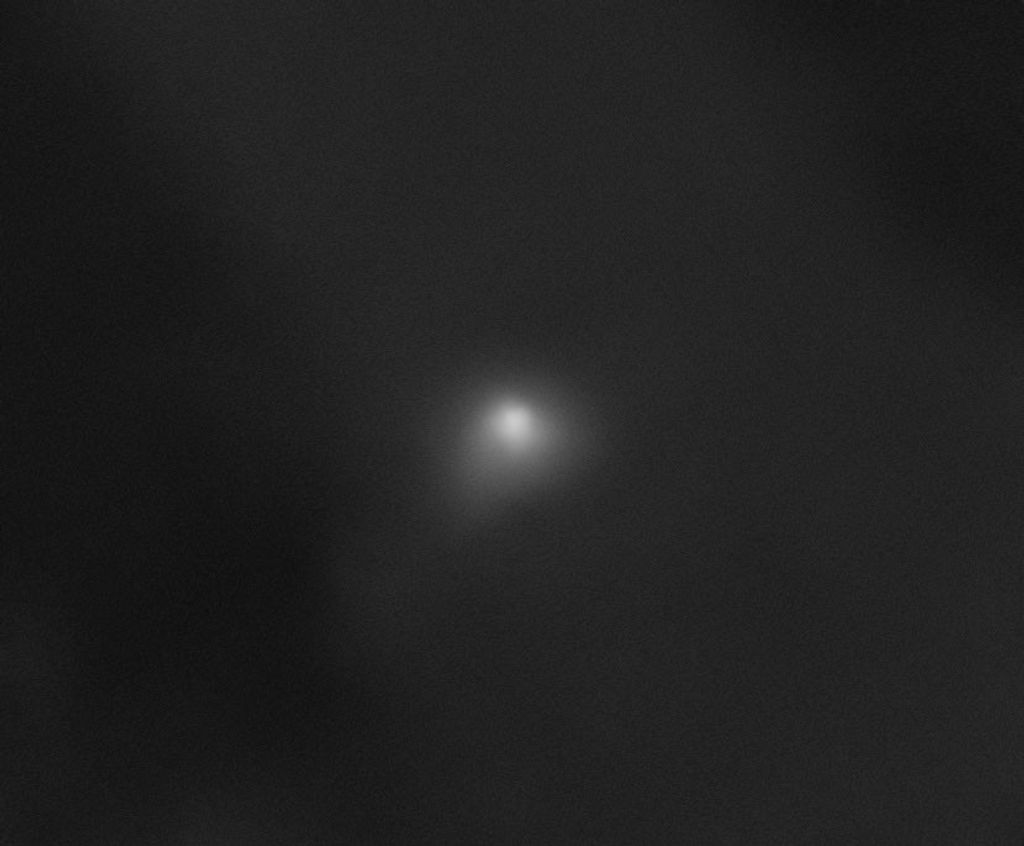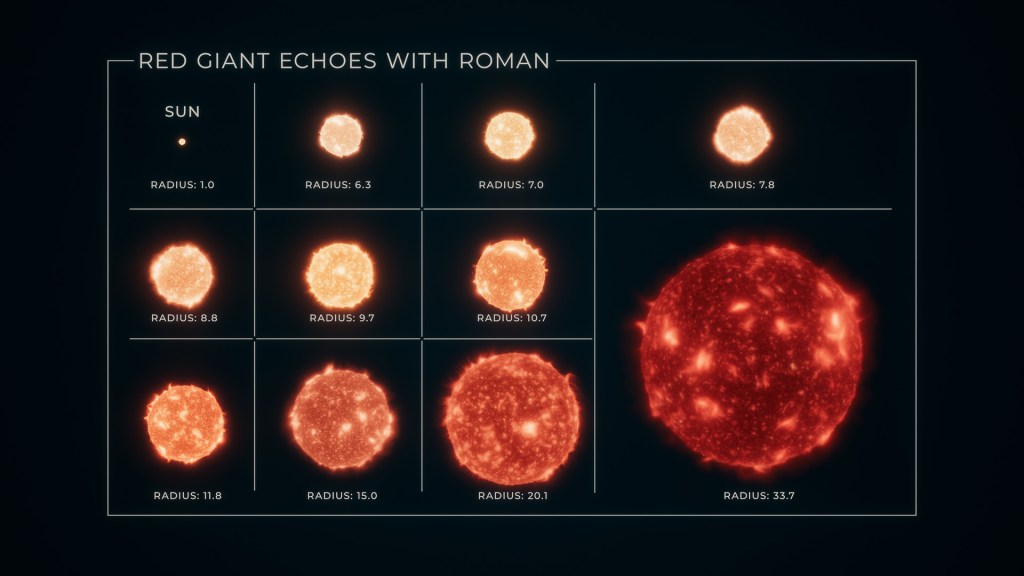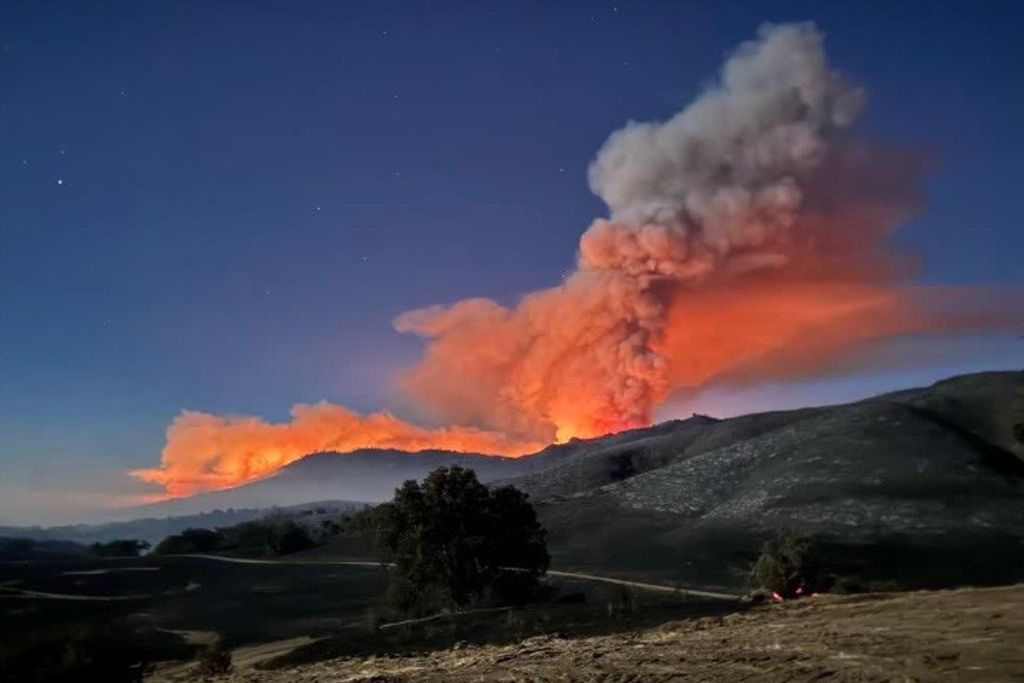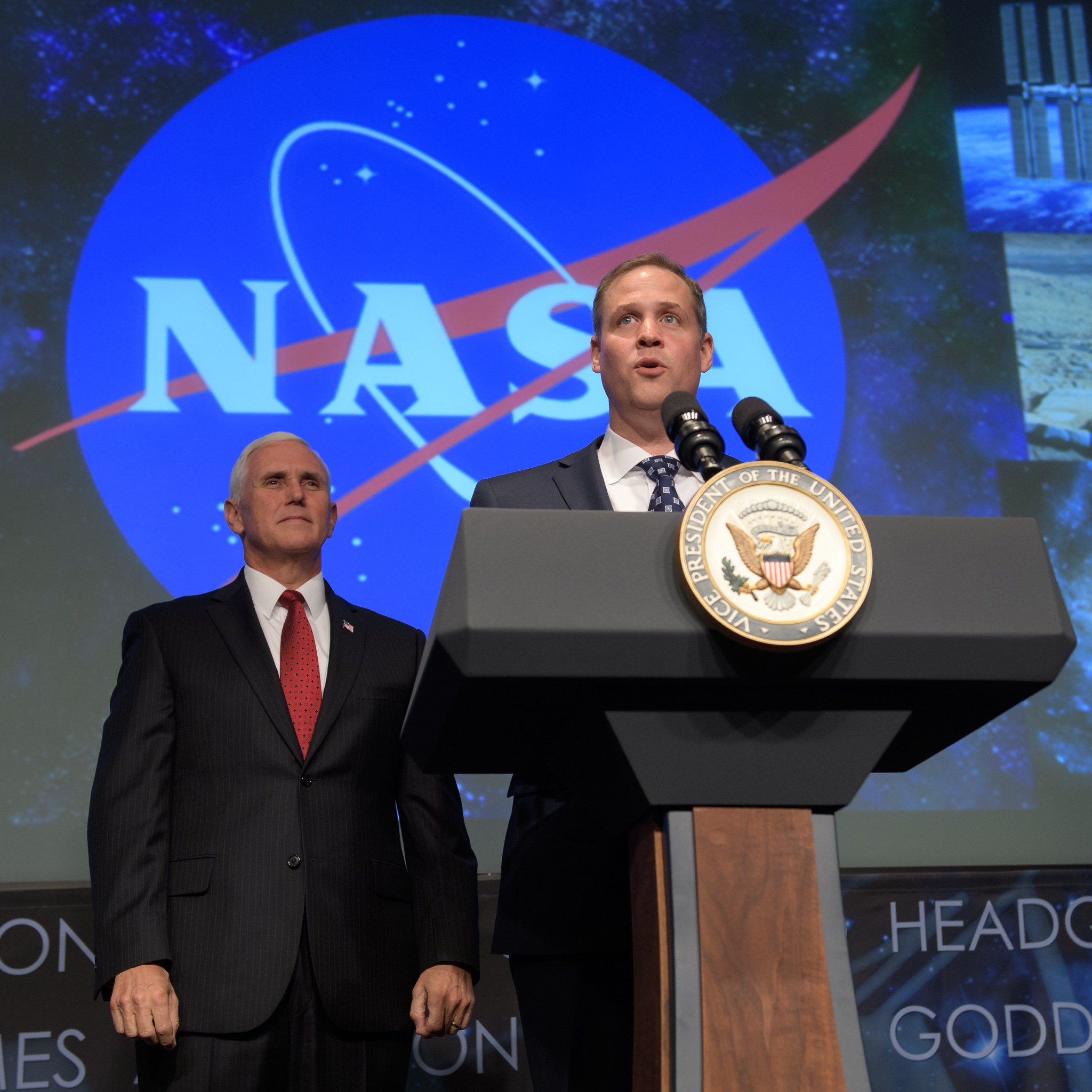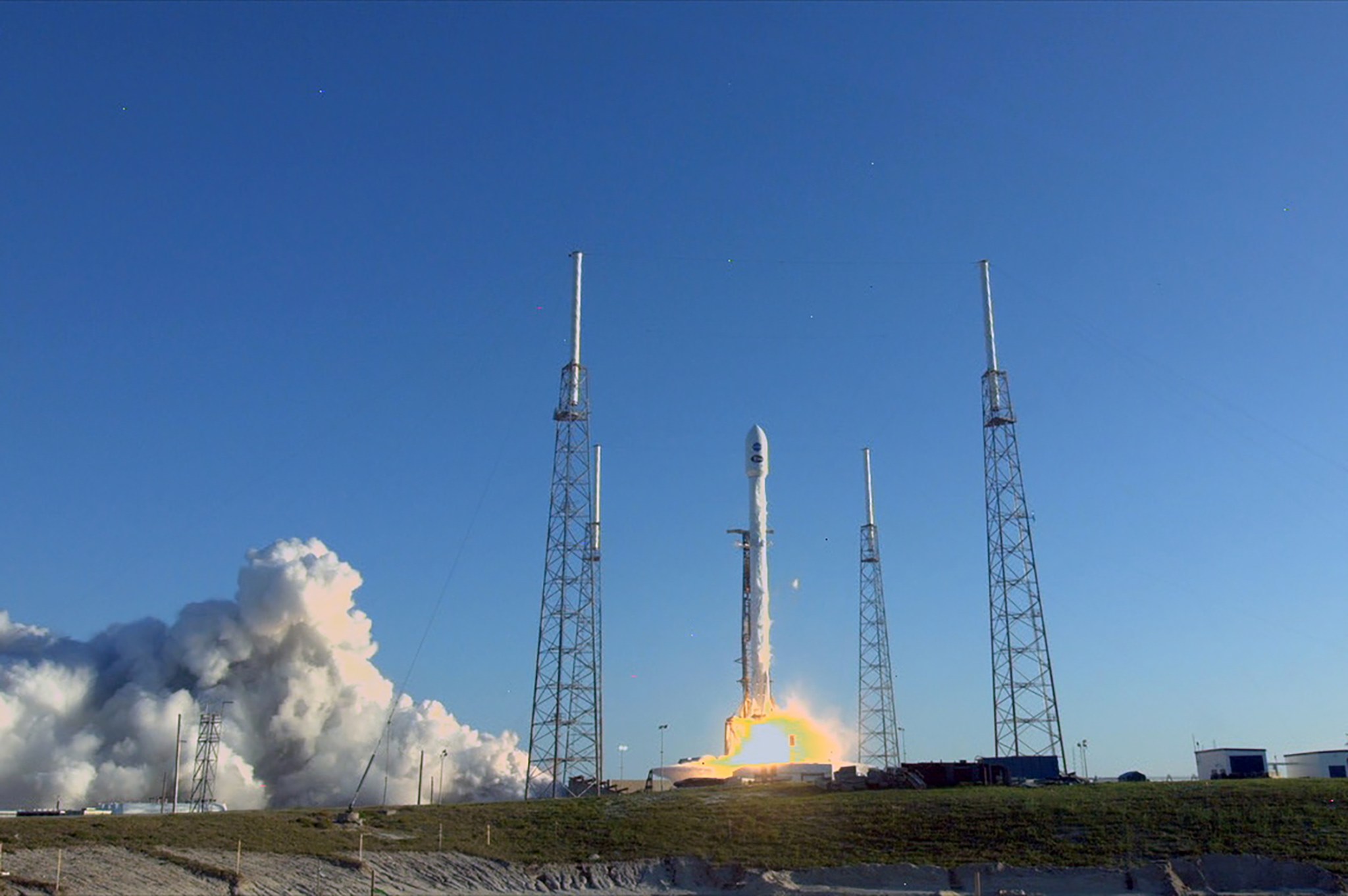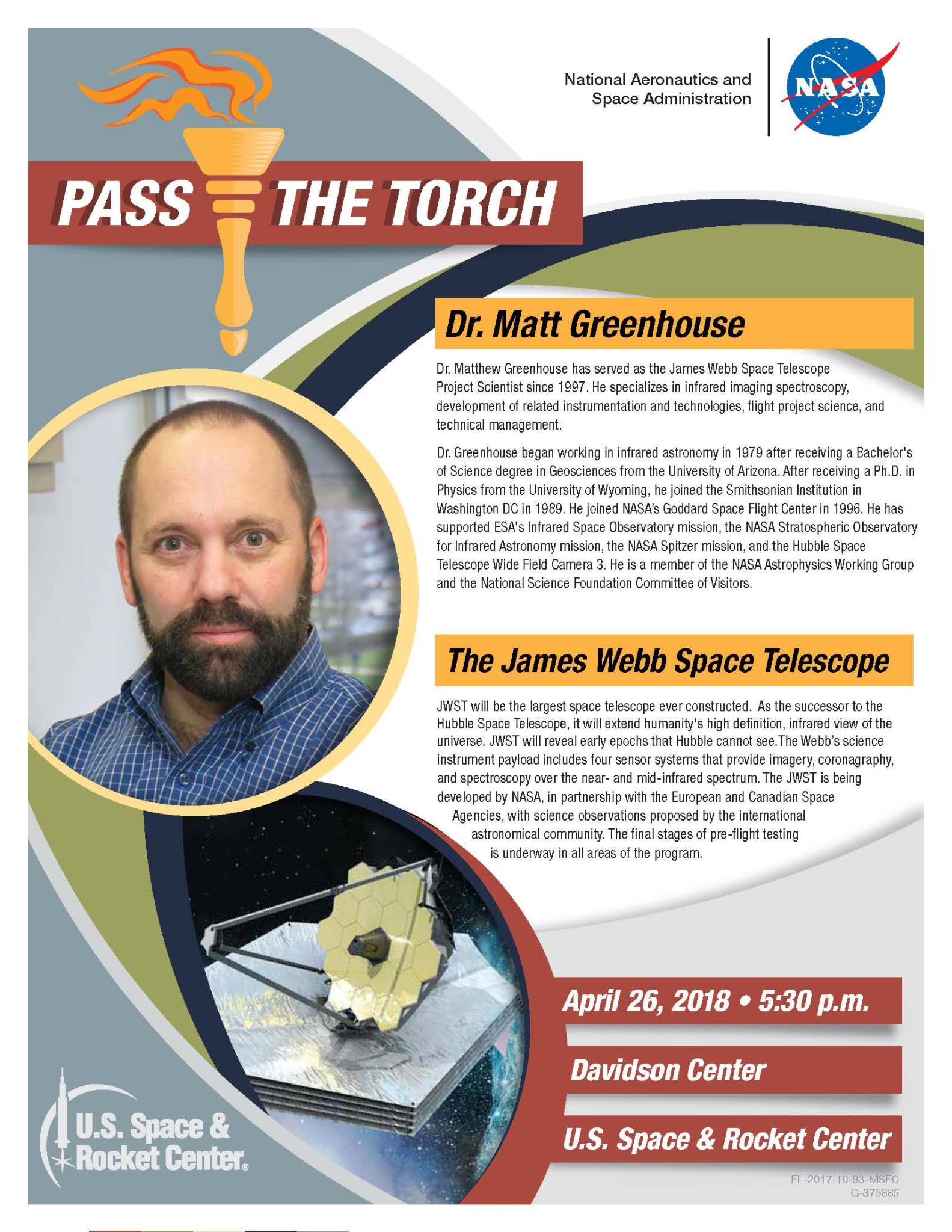In This Week’s Star
- Jim Bridenstine Takes Office as 13th Administrator of NASA
- NASA Planet Hunter on Its Way to Orbit
- Marshall Team Members Invited to Hear Matt Greenhouse, Project Scientist for the James Webb Space Telescope
- NASA, University of Twente Join Forces to Connect Space to Village
- NASA Fitness Challenge Returns April 27; Marshall Team Encouraged to Take Part
- More than 300 Race in Marshall Running Club 5K
- Marshall Programs Featured at Premier Annual Space Conference
- This Week in NASA History: Hubble Space Telescope Launches – April 24, 1990
- Juno Mission Movie Highlighted on ‘This Week @NASA’
- Obituaries
Jim Bridenstine Takes Office as 13th Administrator of NASA
Jim Bridenstine officially took office as the 13th administrator of NASA April 23 after he was given the oath of office by Vice President Mike Pence at the agency’s headquarters in Washington.
Bridenstine was confirmed by the U.S. Senate on April 19, to serve as the agency’s administrator. Prior to this position, he served in the U.S. House of Representatives for the state of Oklahoma, where he held positions on the House Armed Services Committee and the Science, Space and Technology Committee. Bridenstine also is a pilot in the U.S. Navy Reserve and the former executive director of the Tulsa Air and Space Museum and Planetarium.
“I want to thank the President and Vice President for the confidence they have placed in me and the entire NASA family as we continue NASA’s critical missions,” said Bridenstine in an email to NASA team members. “I also want to thank Robert Lightfoot for his strong leadership as the Acting Administrator during a time of transition and for his decades of service to NASA and our nation. His legacy is one of commitment to our mission and leadership in all capacities.”
In his new role at NASA, Bridenstine takes over an agency critical to the nation’s economy, security and technological preeminence.
“NASA represents the best of the United States of America,” said Bridenstine at the April 23 ceremony. “We lead, we discover, we pioneer, and we inspire. I look forward to our journey together.”
As part of the swearing-in ceremony, Vice President Pence and Administrator Bridenstine spoke live with NASA astronauts Scott Tingle, Drew Feustel and Ricky Arnold, who currently are living and working 250 miles above Earth aboard the International Space Station. The astronauts offered congratulations and shared stories of their experiences on the orbiting laboratory.
Following the ceremony, which was attended by Bridenstine’s family, employees and media, the Vice President and new administrator held a meeting with senior agency leadership at headquarters and NASA’s centers via video teleconference.
“The appropriations bill that is now law renews focus on human spaceflight activities and expands our commercial and international partnerships. It also continues our pursuit of cutting-edge science and aeronautics breakthroughs,” Bridenstine told agency leadership.
NASA Planet Hunter on Its Way to Orbit
NASA’s Transiting Exoplanet Survey Satellite launched on the first-of-its-kind mission to find worlds beyond our solar system, including some that could support life.
TESS, which is expected to find thousands of new exoplanets orbiting nearby stars, lifted off April 18 on a SpaceX Falcon 9 rocket from Space Launch Complex 40 at Cape Canaveral Air Force Station in Florida. Just over an hour later, the twin solar arrays that will power the spacecraft successfully deployed.
“We are thrilled TESS is on its way to help us discover worlds we have yet to imagine, worlds that could possibly be habitable, or harbor life,” said Thomas Zurbuchen, associate administrator of NASA’s Science Mission Directorate in Washington. “With missions like the James Webb Space Telescope to help us study the details of these planets, we are ever the closer to discovering whether we are alone in the universe.”
Over the course of several weeks, TESS will use six thruster burns to travel in a series of progressively elongated orbits to reach the Moon, which will provide a gravitational assist so that TESS can transfer into its 13.7-day final science orbit around Earth. After approximately 60 days of check-out and instrument testing, the spacecraft will begin its work.
“One critical piece for the science return of TESS is the high data rate associated with its orbit,” said George Ricker, TESS principal investigator at the Massachusetts Institute of Technology’s Kavli Institute for Astrophysics and Space Research in Cambridge. “Each time the spacecraft passes close to Earth, it will transmit full-frame images taken with the cameras. That’s one of the unique things TESS brings that was not possible before.”
For this two-year survey mission, scientists divided the sky into 26 sectors. TESS will use four unique wide-field cameras to map 13 sectors encompassing the southern sky during its first year of observations and 13 sectors of the northern sky during the second year, altogether covering 85 percent of the sky.
TESS will be watching for phenomena called transits. A transit occurs when a planet passes in front of its star from the observer’s perspective, causing a periodic and regular dip in the star’s brightness. More than 78 percent of the approximately 3,700 confirmed exoplanets have been found using transits.
NASA’s Kepler spacecraft found more than 2,600 exoplanets, most orbiting faint stars between 300 and 3,000 light-years from Earth, using this same method of watching for transits. TESS will focus on stars between 30 and 300 light-years away and 30 to 100 times brighter than Kepler’s targets.
The brightness of these target stars will allow researchers to use spectroscopy, the study of the absorption and emission of light, to determine a planet’s mass, density and atmospheric composition. Water, and other key molecules, in its atmosphere can give us hints about a planets’ capacity to harbor life.
“The targets TESS finds are going to be fantastic subjects for research for decades to come,” said Stephen Rinehart, TESS project scientist at NASA’s Goddard Space Flight Center. “It’s the beginning of a new era of exoplanet research.”
Through the TESS Guest Investigator Program, the worldwide scientific community will be able to conduct research beyond TESS’s core mission in areas ranging from exoplanet characterization to stellar astrophysics, distant galaxies and solar system science.
TESS is a NASA Astrophysics Explorer mission led and operated by MIT and managed by Goddard. George Ricker, of MIT’s Kavli Institute for Astrophysics and Space Research, serves as principal investigator for the mission. TESS’s four wide-field cameras were developed by MIT’s Lincoln Laboratory. Additional partners include Orbital ATK, NASA’s Ames Research Center, the Harvard-Smithsonian Center for Astrophysics and the Space Telescope Science Institute. More than a dozen universities, research institutes and observatories worldwide are participants in the mission.
Marshall Team Members Invited to Hear Matt Greenhouse, Project Scientist for the James Webb Space Telescope
NASA Marshall Space Flight Center team members are invited to hear Matt Greenhouse, project scientist for the James Webb Space Telescope, speak April 26 at 1 p.m. at Marshall and at 5:30 p.m. at the U.S. Space & Rocket Center.
Greenhouse will discuss the James Webb Space Telescope Mission, including the latest results from assembly and testing, as part of the Marshall Tech Talk series, in Marshall’s Building 4220, Room 1103. His discussion of the topic at the Space & Rocket Center’s Davidson Center is part of the Pass the Torch Lecture Series.
The Webb telescope is the world’s next-generation space observatory and successor to the Hubble Space Telescope. It will be the largest space telescope ever constructed, extending humanity’s high definition, infrared view of the universe.
Marshall Tech Talk is a monthly speaker series designed to foster innovation and creativity across the center by featuring topics from a range of disciplines. Pass the Torch is open to the public and features innovative, influential and interesting professionals from industry, academia and government speaking about their work in space, aeronautics, engineering, science research and other related fields.
NASA, University of Twente Join Forces to Connect Space to Village
By Molly Porter
Continuous streams of Earth observations and information made possible by NASA form the foundation for critical environmental planning and decisions by people all over the world. But many organizations and governments are resource-challenged and lack the capacity to put these timely insights to work.
A new partnership between NASA and the University of Twente — a public research university located in Enschede, Netherlands — aims to bridge some of those gaps. Scientific collaboration between the agency’s SERVIR program and the University’s Faculty of Geo-Information Science and Earth Observation — ITC — will help more people in developing countries harness the power of Earth observations and geospatial technologies to solve problems, improve lives and prepare for the future.
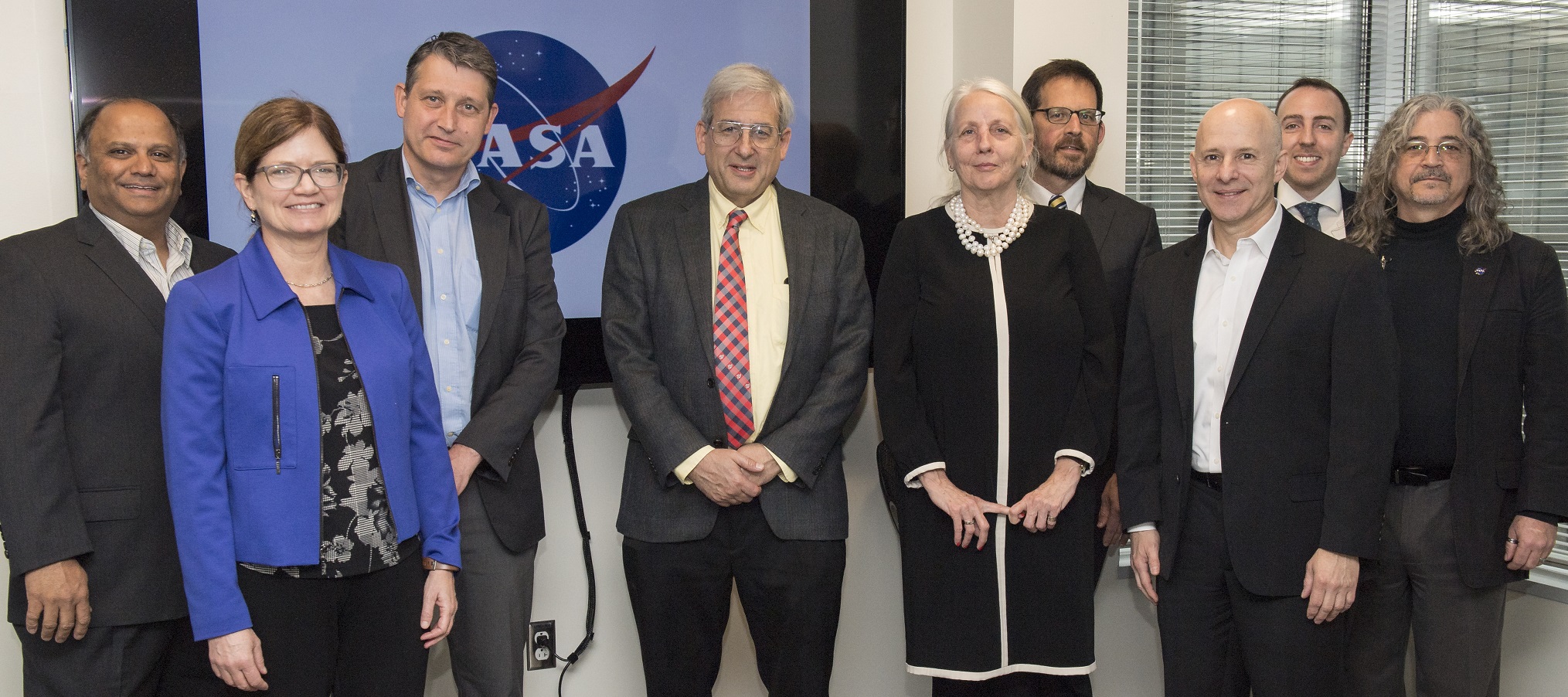
Leaders from both groups met April 17-18 at NASA Headquarters to kick off the 10-year cooperative agreement.
“NASA is passionate about connecting with world-class partners that are already creating positive change,” said Dan Irwin, SERVIR-Global program manager at NASA’s Marshall Space Flight Center. “Through its renowned collaborative educational and research activities, ITC is doing just that — helping vulnerable communities build resilience and thrive in our changing planet.”
SERVIR works in partnership with leading regional organizations worldwide, creating tools, products and services that empower decision makers to better address critical issues related to food security, water resources, natural disasters, land use and weather variability.
The program is already working with more than 45 countries to strengthen awareness of the unique benefits of Earth observations and to increase their use and impact through its network of four regional hubs in Eastern and Southern Africa, West Africa, the Hindu Kush Himalaya region and the Lower Mekong region of Southeast Asia.
ITC is recognized worldwide for achievements in teaching, research and capacity development in the field of geo-information science and Earth observation. ITC educates its students to be professionals capable of acquiring knowledge and translating this into practical applications for solving real-world problems.
“We really look forward to working together on institutional strengthening and regional capacity building with the SERVIR hubs, most of which have already had a long history of collaboration with ITC,” said Dr. Freek van der Meer, vice chairman of the university’s Department of Earth System Analysis. “Together we will focus on the ‘last mile’ to embed Earth observation firmly in society and to help protect communities in developing countries.”
Under the agreement, ITC and SERVIR team members will work hand-in-hand with local teams to develop training, enhance service-delivery and conduct research relevant to the needs of communities in SERVIR hub regions. The partnership will also create unique and innovative opportunities for enriched and continuing education for ITC students and SERVIR scientists.
“This is a phenomenal partnership,” said Irwin. “Together, we’ll leverage each other’s strengths and do more to help ensure that scientific knowledge is applied and creates even greater societal benefits.”
Building and relying upon a growing network of partners is foundational to the SERVIR program. SERVIR, which means “to serve” in Spanish, is a joint development initiative of NASA and the U.S. Agency for International Development in Washington.
SERVIR’s four hubs include the Regional Centre for Mapping of Resources for Development in Nairobi, Kenya; the International Centre for Integrated Mountain Development in Kathmandu, Nepal; the Asian Disaster Preparedness Center in Bangkok, Thailand; and the Agrometeorology, Hydrology and Meteorology Regional Center in Niamey, Niger.
NASA Fitness Challenge Returns April 27; Marshall Team Encouraged to Take Part
NASA’s Marshall Space Flight Center will take part in the agency’s fifth annual NASA Moves! Fitness Challenge April 27 to May 26.
Sponsored by NASA’s Office of the Chief Health and Medical Officer, the four-week challenge is designed to help team members form lasting healthy habits, set personal health and fitness goals, increase their activity levels and become better educated about healthy food choices. Step challenges will help participants turn yard work, household chores, sports activities, shopping excursions and even bedtime preparations into healthy ways to burn calories and increase personal fitness.
“So many of us are desk workers leading sedentary lifestyles, and the easiest way to counter the negative effects of that is just to get up and move,” said Lorna Howell, Marshall’s Occupational Health program manager in the Office of Center Operations. “Any purposeful activity helps promote good health — burning calories, fighting obesity and heart disease. A special challenge such as NASA Moves! helps keep us all more mindful of the need to protect and maintain our bodies, especially as we get older.”
The challenge is even structured to serve team members with physical limitations or compromised mobility, she noted — meaning everyone can take part, pursuing activities within their physical means and daily schedule.
Marshall team members can find more information on ExplorNet. Howell also suggested they visit NASA’s Heath4Life website, the primary information hub for the challenge, offering guidelines, frequently asked questions, team captain advice and more. Registration for the challenge is open now through May 18.
New fitness challenge awards, activities and games are available at the FitThumb website. New users will be prompted to create a User ID to start.
In 2017, more than 3,700 NASA team members on 375 teams took part in the fitness challenge, achieving the agency’s goal of 1 billion steps taken. New awards, activities and games are expected to keep participants engaged this year and help achieve even greater collective results, Howell said.
For more information, contact Howell or email program leads Susan Nida or Annette Maynard, health and welfare specialists at NASA’s Kennedy Space Center.
More than 300 Race in Marshall Running Club 5K

Runners take off from the starting line at NASA Marshall Space Flight Center’s Running Club 5K race April 18 at the Marshall Wellness Center. More than 400 runners registered for the annual spring race, and 325 finished, including 19 new runners who completed the club’s Couch to 5K beginner training program. The overall men’s winner was Josh Whitehead, and Jessica Wood was the fastest female runner. (MSFC/Emmett Given)
Marshall Programs Featured at Premier Annual Space Conference
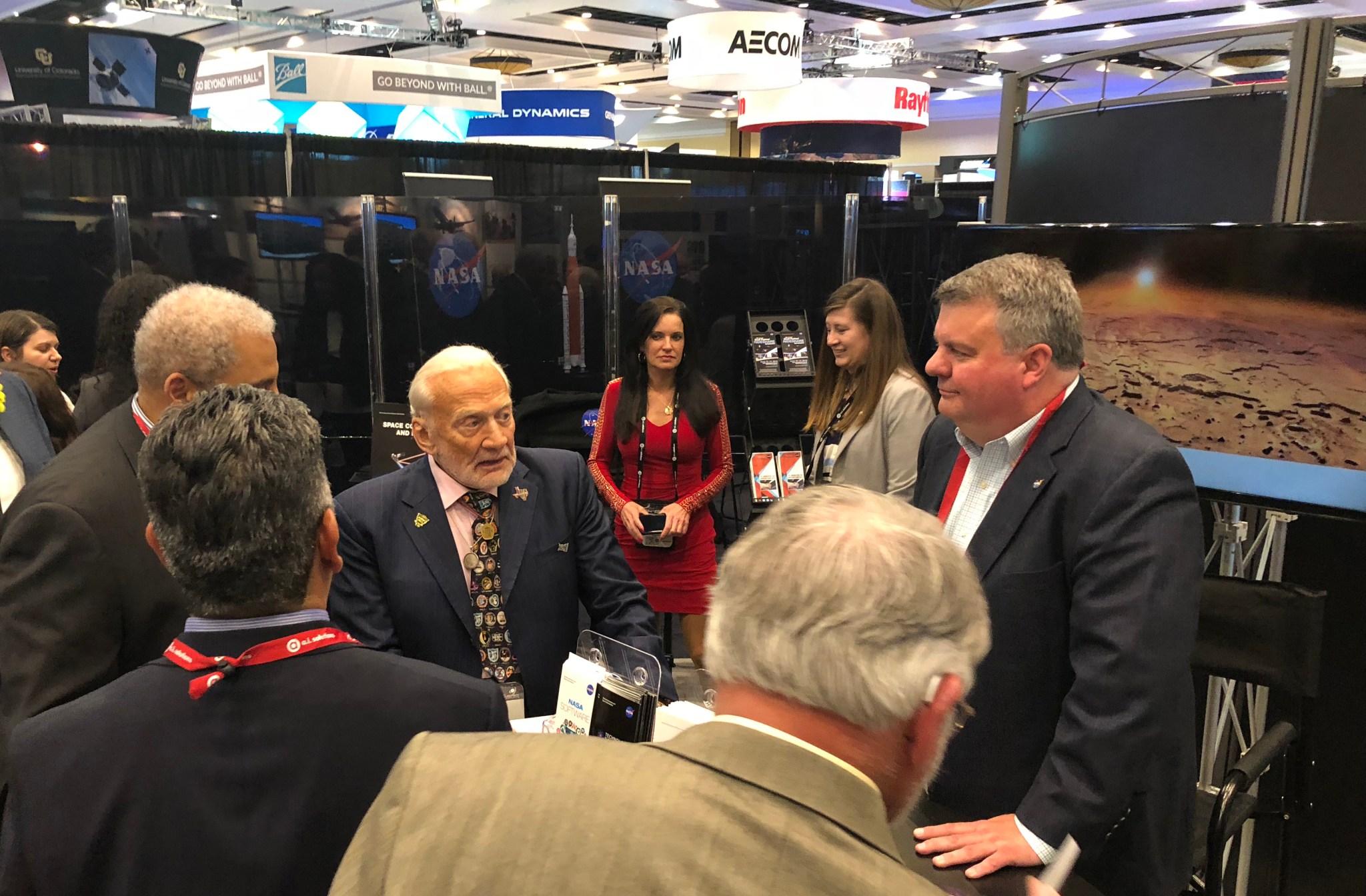
Former NASA astronaut Buzz Aldrin, center, talks with Terry Taylor, right, manager of the Technology Transfer Program office at NASA’s Marshall Space Flight Center, at the 34th Space Symposium in Colorado Springs, Colorado. The Technology Transfer Program ensures that the technologies developed for agency missions are made available to the public, and that the spinoff benefits of NASA technologies are made known. The Space Symposium is an annual gathering of space professionals and leaders from government and industry. (NASA/MSFC/Amber Jacobsen)
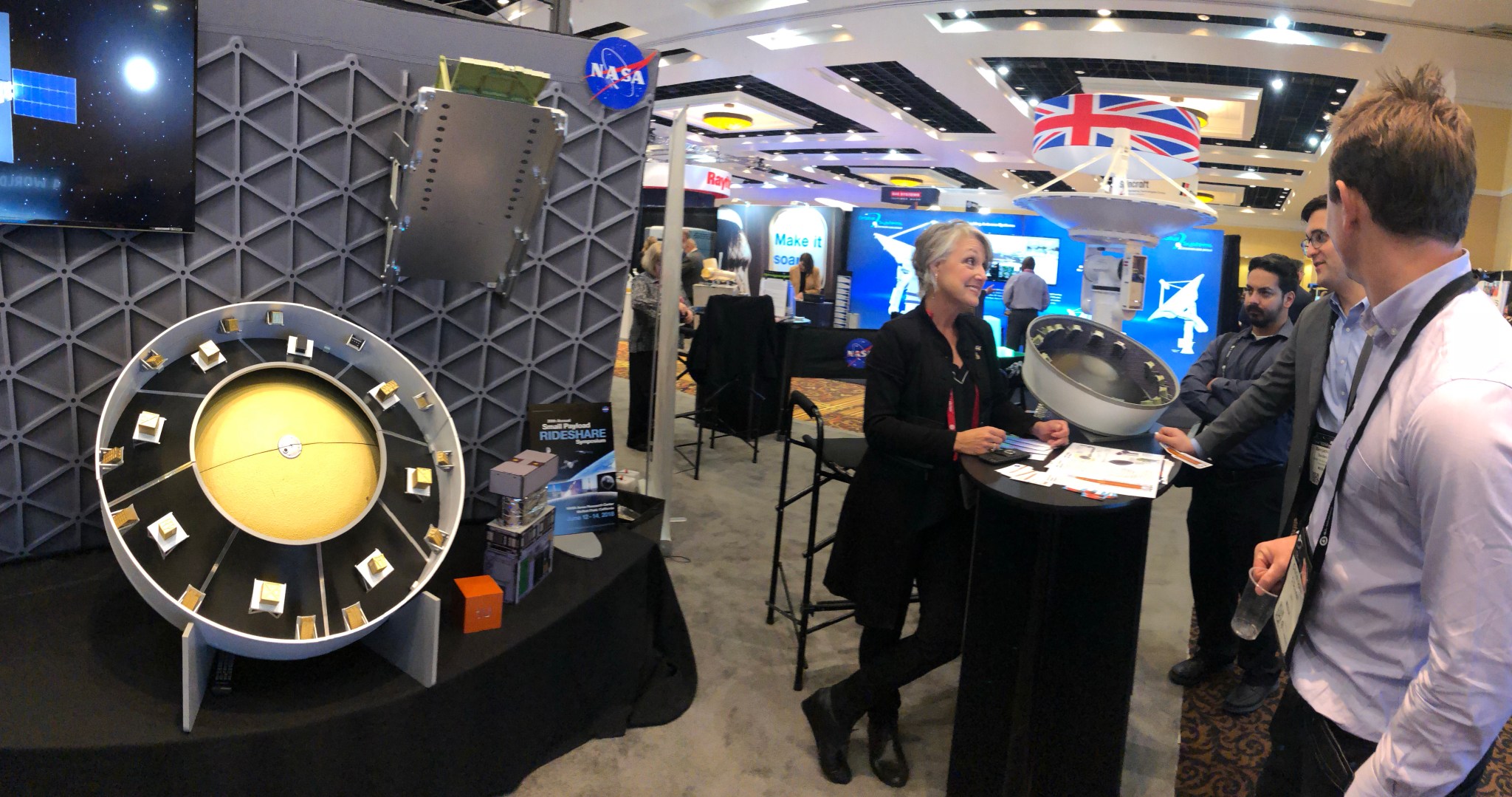
Marcia Lindstrom, strategic communications manager for NASA’s Space Launch System, talks to guests about the rocket and the secondary payloads that will ride along with it at the 34th Space Symposium in Colorado Springs, Colorado. The exhibit models represent a stage adapter ring that will connect the Orion vehicle to the SLS and also carry 13 CubeSats on the first flight of the SLS rocket. (NASA/MSFC/Janet Sudnik)
This Week in NASA History: Hubble Space Telescope Launches – April 24, 1990
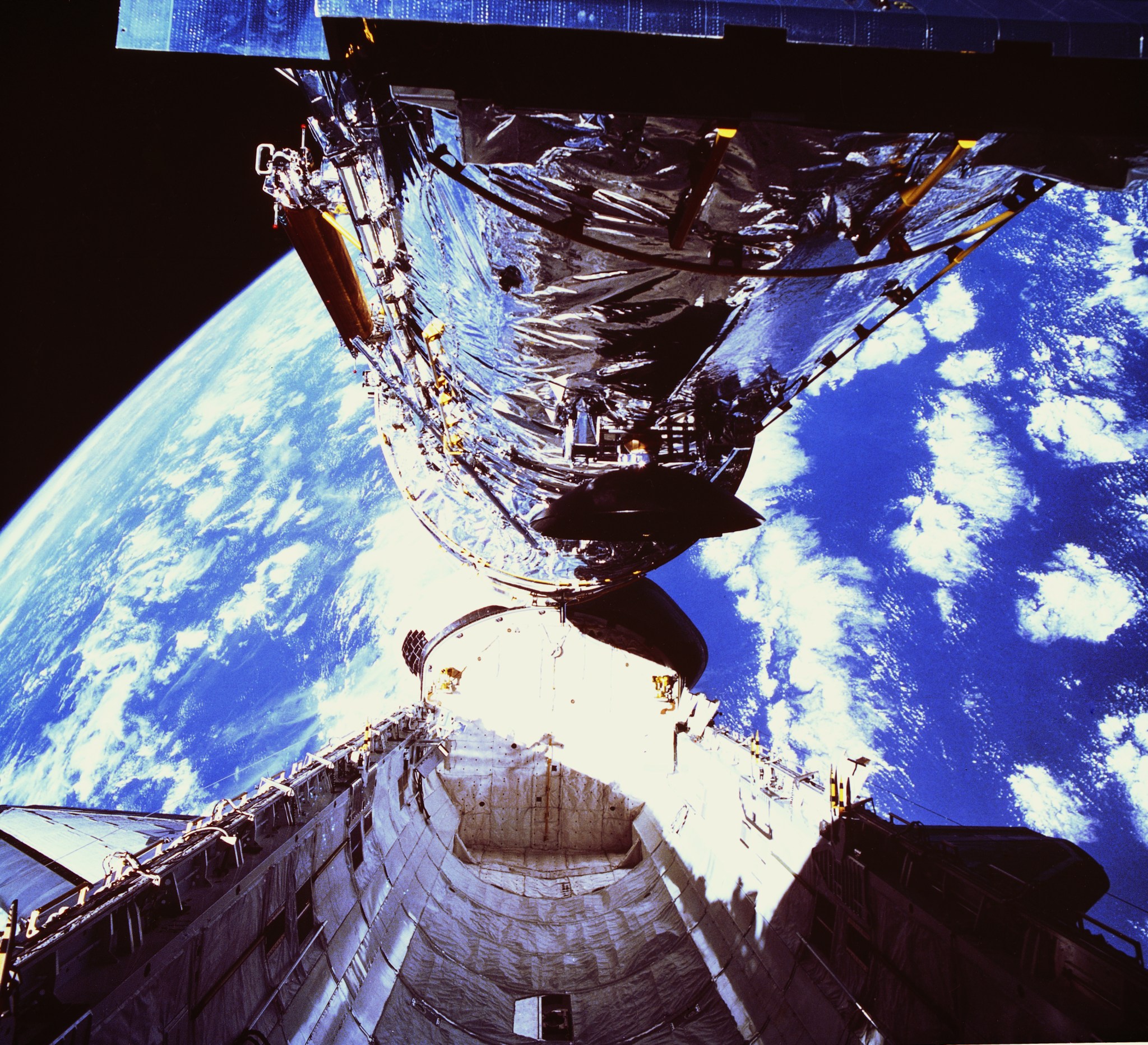
This week in 1990, space shuttle Discovery, mission STS-31, launched from NASA’s Kennedy Space Center on a five-day mission to deploy the Hubble Space Telescope. Here, Hubble clears the orbiter’s cargo bay during its deployment on April 25, 1990. NASA’s Marshall Space Flight Center was responsible for the overall design, development and construction of the observatory. The NASA History Program is responsible for generating, disseminating and preserving NASA’s remarkable history and providing a comprehensive understanding of the institutional, cultural, social, political, economic, technological and scientific aspects of NASA’s activities in aeronautics and space. For more pictures like this one and to connect to NASA’s history, visit the Marshall History Program’s webpage. (NASA)
Juno Mission Movie Highlighted on ‘This Week @NASA’
A new movie generated from the Juno mission is featured in “This Week @NASA,” a weekly video program broadcast nationwide on NASA-TV and posted online.
Data from NASA’s Juno mission to Jupiter has been used to create a 3-D infrared movie showing densely packed cyclones and anticyclones permeating the planet’s polar regions and the first detailed view of a dynamo — or engine — powering the magnetic field for any planet beyond Earth. The imagery will help the Juno mission team understand the forces at work in the animation.
The Juno mission is managed by NASA’s Marshall Space Flight Center as part of NASA’s New Frontiers Program.
View this and previous episodes at “This Week @NASA” on NASA’s YouTube page.
Obituaries
Sandor L. Lehoczky, 80, of Huntsville died April 7. He retired from the Marshall Center in 2011 as a materials scientist. He is survived by his wife, Julianne Lehoczky.
David Aichele, 87, of Ooltewah, Tennessee, died April 11. He retired from the Marshall Center in 1994 as a data systems supervisor.














